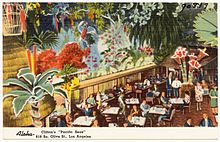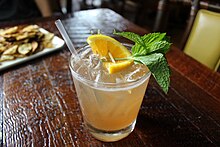Tiki culture
Beginning in California in the 1930s and then spreading around the world, Tiki culture was inspired by the sentimental appeal of an idealized South Pacific, particularly Polynesia, as viewed through the experiences of tourists and Hollywood movies, incorporating beautiful scenery, forbidden love, and the potential for danger.
Tiki culture changed over time, influenced by World War II and the firsthand exposure hundreds of thousands of American servicemen gained during that conflict.
[17] His restaurant featured Cantonese cuisine and exotic rum cocktails and punch drinks, with a décor of flaming torches, rattan furniture, flower leis, and brightly colored fabrics that looked like imagery out of the popular movies that were helping to fuel the desires of the average American to travel the Pacific.
Bergeron adopted the new persona in a manner to imitate Beach's theatrics and further perpetuate the illusions of Hollywood, telling people that the leg he had lost to tuberculosis had been the result of being attacked by a shark.
[24][25] Hei Tiki was released in 1935, with a New York Times review describing the plot as being about "a chieftain's daughter who is declared tabu and destined to be the bride of the war god".
[citation needed] During a time when overseas civilian China Clipper air travel was still uncommon, the Hawaiian Steamship Company's Matson Line also continued its aggressive advertising campaigns promoting a leisurely but still exotic island lifestyle, led by famous photographers such as Edward Steichen and Anton Bruehl and featuring actresses such as Jinx Falkenburg (later in Sweetheart of the Fleet and Tahiti Nights).
[citation needed] When American servicemen returned home after the end of World War II in 1945, they brought with them stories and souvenirs from their time in the South Pacific that helped to reinforce the popularity of what Hollywood had set the stage for Donn Beach to create.
Heyerdahl's work also expanded the theme's mythology to include the west coast of South America in what became an ever increasing mix of cultural motifs, both real and imagined.
Crane is generally credited with also bringing tiki to the forefront of decorations at such restaurants and bars, prominently placing their image on his menu covers, matchbooks, entry ways, and other signage.
[24] He opened a Don the Beachcomber there, along with the Dagger Bar and created a treehouse office in the top of a giant banyan tree that oversaw a complex of multiple thatch-roofed buildings and huts that sold a variety of goods from around the tropical world.
Other tiki bars opened in Hawaii as well, initially staffed by native bartenders who did not recognize the allegedly Hawaiian drinks that American tourists were requesting.
[38] Single family homes, apartment complexes, bowling alleys and other business were heavily influenced by assumed Polynesian aesthetics, in some cases incorporating the motif into entire residential areas and shopping districts.
[citation needed] If Tiki culture began as a restaurant theme made to look like a Hollywood set, alcoholic drinks dressed up in elaborate barware are its cornerstones and main actors.
[46] He was the first restaurateur to focus an entire drink menu on the mixing of flavored syrups and fresh fruit juices with rum, which he called "Rhum Rhapsodies" and were served in fancy glasses, hollowed out pineapples, and drilled coconuts.
[48] Over time many restaurateurs had begun to copy, and in some cases steal, Beach's cocktail recipes and template for immersive island decorations coupled with "newly discovered" Southeast Asian/Polynesian food (rumaki, crab rangoon, etc.).
[citation needed] Some drinks served at tiki bars include co-opting previous cocktails with exotic sounding names or foreign backstories, such as the Bloody Nelson, Blow My Skull, Boomerang, Corpse Reviver, Diki-Diki, Doctor Funk, Planter's Punch, and Singapore Sling.
[53][54][55][56][57] While many were created expressly as "tiki drinks" (although such a term was not used at the time), others were simply new World War II era cocktails made overseas that could quickly be assimilated into the formula, such as the case with the Suffering Bastard.
[59] The disagreement between Beach and Bergeron over who created the Mai Tai was not an isolated incident, and who "invented" what drink and when was frequently obscured by establishments that served cocktails with the same name but in sometimes remarkably different manners.
[citation needed] Tiki drinks, as they are generically called, are typically heavily garnished, with ample fruit, swizzle sticks, cocktail umbrellas, or flowers.
[citation needed] An increasing emphasis on idealized "wahine" (island women) saw their depiction grow from menu cover placement to their use on tiki barware.
The Fog Cutter mug and the Kava Bowl were two of the earliest ceramic tiki drinking vessels bearing the images of such women to be used in Trader Vic's restaurants.
[68] Gardenia, hibiscus, and florals became a more popular fabric pattern in America, as did palm fronds and similar types of tropical plants or animals such as fish and birds.
Tourism continued ever bigger growth, with the years after statehood becoming a "jet rush" for vacationers snapping up $100 tickets for a now only five-hour flight from Los Angeles or San Francisco without the former restrictions of the former Territory of Hawaii.
Born in Peru, she was not Polynesian but she quickly became famous because of her diverse vocal range and in 1946 her home government formally supported her claim to be a descendant of Atahualpa, the last Incan emperor.
Sandra Warner was showcased on the album cover for Exotica, helping it to reach no.1 on the Billboard charts and eventually giving the entire genre its name.
Tiki exotica on the other hand was introduced in Martin Denny's Waikiki nightclub jungle noises arrangement in Baxter's song "Quiet Village".
[102][103] The visual iconography of TV series Gilligan's Island (1964–1967) borrowed significantly from an assumed tiki culture with huts and furniture resembling a fantasy-Polynesian castaway village.
Psycho Suzi's Motor Lounge opened featuring motifs of tattooed hula girls sporting suicide rolls and a parking lot accommodated for motorcycles.
It describes itself by saying: "We take lovingly-remembered tiki bar history, a healthy helping of tattoo culture, several measures of kitsch, a dash of voodoo and a passion for good times, stick them all in a blender and hit Liquify".
Some criticize tiki bars as a seductive form of cultural appropriation[184][185][186] which can obscure and subsume native traditions and divert attention from the history of violent colonialism in the region.

















